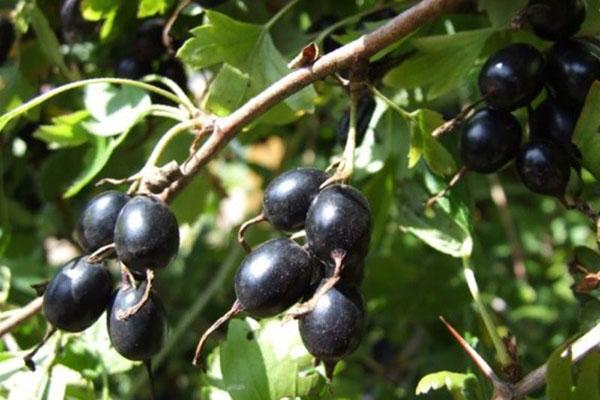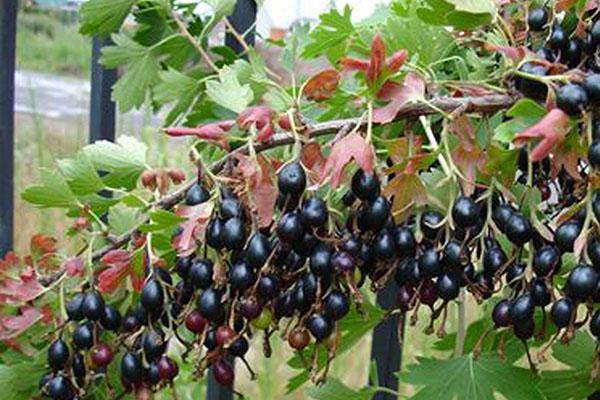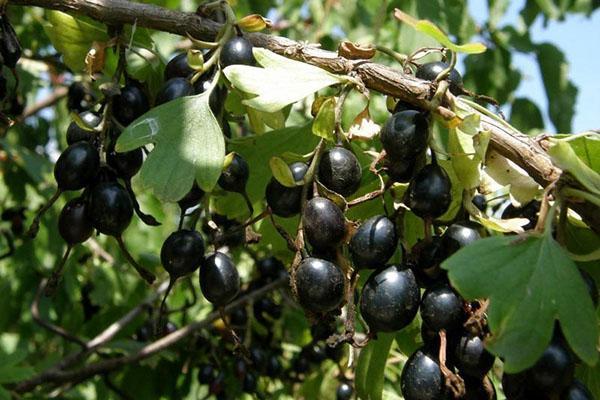What is delicious yoshta berry?
 Breeding has given the world many new species of hybrid plants, and yoshta is no exception. What is it that interests every gardener and owner of a personal plot. The varieties of the hybrid differ in yield, fruit size and disease resistance.
Breeding has given the world many new species of hybrid plants, and yoshta is no exception. What is it that interests every gardener and owner of a personal plot. The varieties of the hybrid differ in yield, fruit size and disease resistance.
Read also about planting golden currants!
Joshta: what is it?

Yoshta - hybrid currants and gooseberries. An adult bush reaches 2.5 m in height. Powerful woody shoots have no thorns. The gray-brown branches are intertwined. Crown diameter: 1.5-2 m. Shoot formation is weak.
The branched root system extends 35-45 cm into the soil. Large openwork leaves are located on thick cuttings. Light supply veins are expressed on the inner side of the sheet plate.
Large yellow or white-pink flowers are collected in inflorescences. The petals are even, smooth. Yoshta blooms in mid-June.
Berries, black with a purple tint, are arranged on clusters of 4-6 pieces. The smooth skin is firm and firm. The pulp is juicy, aromatic with a spicy nutmeg flavor. Ripe berries are sweet, without jelly and bitterness. Weight of one fruit: 2.5-5.5 g.
Ripe berries do not crumble or rot. Transportable, after collection they are stored in special containers for up to 5-7 days. They do not lose their taste and presentation.
A description of yoshta would be incomplete without the characteristics of the plant:
- The shrub is resistant to frost and temperature extremes. It is grown in regions with a variable climate.
- Not affected by common aphids and scale insects.
- Tolerates exposure to direct sunlight.
- Berries are universal in use, used in cooking for the preparation of compotes, juices, preserves, jams and desserts.
Yoshta's lifespan: 25-35 years. The plant is widespread in Western Europe, central and southern regions of Russia.
Yoshta varieties
Descriptions of varieties and photos of yoshta will help the gardener choose a plant that is suitable for the specific climatic conditions of the region. All varieties are distinguished by their lack of thorns and uneven ripening of berries.
British variety EMB
 The variety was developed by British breeders in the early 1980s. A medium-sized plant reaches 1.7 m in height. Dark green leaves 5-8 cm in diameter expand towards the base. The flowering period begins in late April and lasts 2-2.5 weeks.
The variety was developed by British breeders in the early 1980s. A medium-sized plant reaches 1.7 m in height. Dark green leaves 5-8 cm in diameter expand towards the base. The flowering period begins in late April and lasts 2-2.5 weeks.
Large oval berries weighing up to 4.5 g of blue-black color. The fruits are sweet, aromatic, with small seeds inside. The berries ripen for 2.5 months.
Swiss Crohn variety
 Bred in Switzerland. A short bush grows up to 1.5 m long. Sprawling woody shoots, thickened at the base. Round berries are small or medium. Fruit weight: 1.5-2 g. 3-6 berries ripen in a bunch.
Bred in Switzerland. A short bush grows up to 1.5 m long. Sprawling woody shoots, thickened at the base. Round berries are small or medium. Fruit weight: 1.5-2 g. 3-6 berries ripen in a bunch.
The yield is average, up to 3.5 kg of fruits are harvested from one bush. The variety is frost-resistant, does not suffer from night frosts and cold dews.
Yoshta Rext
 Height of thin erect shoots: 1.3-1.5 m. Large black berries weighing up to 3.5 oval. The pulp is sugary, with a pronounced currant aroma. The oblong seeds are small.
Height of thin erect shoots: 1.3-1.5 m. Large black berries weighing up to 3.5 oval. The pulp is sugary, with a pronounced currant aroma. The oblong seeds are small.
The yield is high: up to 10.4 kg of fruits are harvested from each bush. Ripe berries dry and fall off the stalks. Fruits are resistant to gray mold and spotting.
Yohini hybrid variety
 The first hybrid variety of Yoshta. The plant is tall, reaches 2 m in height. Wide sheet plates are cut with wrinkles. White flowers are collected in inflorescences. The round, dark blue berries are sweet and aromatic. Up to 9 kg of fruits are removed from the bush.
The first hybrid variety of Yoshta. The plant is tall, reaches 2 m in height. Wide sheet plates are cut with wrinkles. White flowers are collected in inflorescences. The round, dark blue berries are sweet and aromatic. Up to 9 kg of fruits are removed from the bush.
Yoshta Moro
 The plant grows up to 2-2.3 m long. Dark berries are large, the skin is covered with a waxy coating. The pulp is sweet and sour with a pronounced nutmeg aroma. The fruits do not crumble when ripe, they are attached to long sturdy stalks.
The plant grows up to 2-2.3 m long. Dark berries are large, the skin is covered with a waxy coating. The pulp is sweet and sour with a pronounced nutmeg aroma. The fruits do not crumble when ripe, they are attached to long sturdy stalks.
The variety is resistant to frost and disease. In the shade, the leaves darken, and the number of flowers and ovaries decreases. With a lack of moisture, the berries stop growing and dry out.
Descriptions of varieties and photos of Yoshta can be found in the plant breeding guide. Scientists annually develop new varieties, improving the technical characteristics of the shrub and the taste of the fruit.
Useful properties and contraindications of yoshta
 Yoshta fruits have absorbed all the beneficial properties gooseberry and currants. Caloric content of 100 g of berries: 45 kcal. The pulp contains fats, proteins and carbohydrates.
Yoshta fruits have absorbed all the beneficial properties gooseberry and currants. Caloric content of 100 g of berries: 45 kcal. The pulp contains fats, proteins and carbohydrates.
Beneficial features:
- Restores hemoglobin, in combination with drugs, treats anemia.
- Contains vitamin C, strengthens the immune system. Treats colds and SARS.
- Normalizes the activity of the gastrointestinal tract, eliminates diarrhea and bloating.
- Berries mixed with honey help with hypertension and arrhythmias.
- The phytoncides contained in the fruits eliminate inflammation and fungal infections.
- The pulp is rich in vitamin P, normalizes blood flow, strengthens blood vessels and veins.
Regular consumption of yoshta berries helps to remove toxins and toxins from the body. The fruit is recommended for people with diabetes. Helps to reduce body weight and restore muscle tissue.
Contraindications for yoshta:
- Cannot be used with individual intolerance to the components of the composition and allergic reactions to the product.
- Contraindicated in people with a risk of thrombus formation.
- Use with caution for ulcers, gastritis, Crohn's disease and colitis.
If a person is allergic to currants or gooseberries, then it is recommended to refuse the use of yoshta.
Useful properties and contraindications of yoshta decrease with conservation. Heat treatment reduces the concentration of vitamin C in fruits, which causes allergic reactions. Phytoncides acting in fresh berries are not preserved in jams and compotes.
Having learned what yoshta is, every gardener will want to plant this berry bush with tasty and healthy fruits on the site. The unpretentiousness, productivity and versatility of the use of fruits made the plant popular in Russia.
Read also about irgu berry!
Why are all the merits for breeding yoshta attributed to German breeders?
We had such bushes in our village in the early 70s. And we called them Michurinskaya currant. And here the Germans? Michurin had already brought everything out before them. And we ate these berries with pleasure, without the Germans, with our Michurin!
I know this berry, it tastes great, fruits are black, yellow and red. We also called it currant, although in the market it was called game. People did not yet know what kind of berry it was. We planted it on the terraces of the hills and we collected it in buckets. Then, in the early 80s, few knew what it was called, but they made jams, compotes from it and just ate it, the harvest was very large. Over time, the bushes dried up from old age, but many of them grow at home.